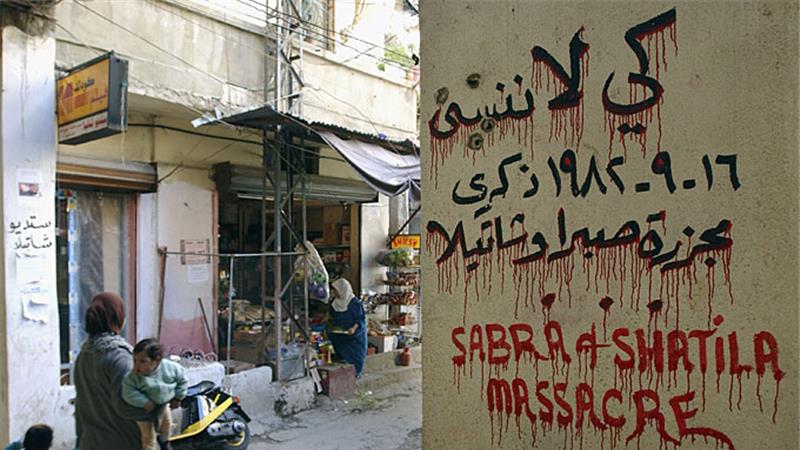Alwaght- One of the entrances of the Shatila refugee camp set up for Palestinians near the southern suburbs of Beirut is called Sabra. It’s a bustling street market renowned for its cheap prices during the day and dangerous fights at night. Vegetables, clothes, and toys can be found at the lowest prices along with the stench of sewage that runs along the street. The 67 year old camp, however, is not just a place that houses up to 10,000 Palestinian refugees and people from other nationalities. It is a place that was marred with blood and littered with dead bodies, exactly 34 years ago.
On September 16, 1982 the Sabra and Shatila massacre took place making headlines around the world.

Under the cover of their Israeli allies, the Phalange militia group raided Sabra and Shatila and committed a massacre over the course of two days, from 6:00 pm September 16 to 8:00 am September 18 of 1982.
The Israeli Occupation Force ordered the Phalanges to empty Sabra and Shatila from members of the Palestine Liberation Organization and Shiites who were hindering the Israelis’ advance into West Beirut. The result of this order was vicious.
Falsely claiming that Palestinians had assassinated then leader of the Lebanese Kataeb Party Bachir Gmayel, the Phalange said the massacre was an act of retaliation when in fact the PLO had withdrawn from the area before the slaughtering took place.
It cannot be denied that many were aware of the raid before it occurred. Israeli forces, Phalangists and members of the treasonous South Lebanon Army surrounded Sabra and Shatila on that day. Israeli troops even blocked the exits of the camp to prevent residents from escaping the bloodshed.
In 1983, a commission chaired by Seán MacBride, the assistant to the UN Secretary General and President of United Nations General Assembly, concluded that the Israeli regime was responsible for the violence. The commission also concluded that the massacre was a form of genocide, the deliberate attempt to wipe out a people.
Then Defense Minister Ariel Sharon, bore personal responsibility "for ignoring the danger of bloodshed and revenge" but failed to admit his implication. He sued Time magazine for libel over a story which implied that Sharon "reportedly discussed with the Gemayels the need for the Phalangists to take revenge" for the assassination.
It was a Thursday evening when the first unit of Phalangists stormed into Sabra and Shatila to initiate the killings. Reports say that Palestinians were forced to line up for their execution, to wait and see or hear other Palestinians being shot dead before their turn arrived. According to one Dutch nurse’s description, the camp was as bright as "a sports stadium during a football game" during the night when the Israelis fired illuminating flares over the area.
Norwegian journalist and diplomat Gunnar Flakstad managed to get into the camp during operations and stood witness to the brutality of the Phalangists. His account of the incident includes mutilated bodies, castrations and scalping. As he helped remove bodies from destroyed homes, he even noticed the Christian cross carved into Palestinian boys’ bodies.
Following the massacre, Janet Lee Stevens, an American journalist, wrote to her husband, Dr. Franklin Lamb, “I saw dead women in their houses with their skirts up to their waists and their legs spread apart; dozens of young men shot after being lined up against an alley wall; children with their throats slit, a pregnant woman with her stomach chopped open, her eyes still wide open, her blackened face silently screaming in horror; countless babies and toddlers who had been stabbed or ripped apart and who had been thrown into garbage piles.”

While most sides agree on the atrocities committed within the camp, the exact number of slain civilians is not clear. The Lebanese army’s chief prosecutor had counted 460 bodies, including 15 women and 12 children. However, Israeli intelligence claimed that 700 to 800 were killed while the Palestinian Red Crescent put the number of casualties at 2,000.
According to journalist Robert Fisk, “After three days of rape, fighting and brutal executions, militias finally leave the camps with 1,700 dead”.
What is certain is that a bloody and ruthless massacre took place in the Sabra and Shatila area. There are pictures to back history and videos to double back it. Pools of blood, dead bodies, and destroyed homes spoke the dreadful truth about what began that day, on September 16 and ended on September 18 1982. Today, as people pass by the entrance to Sabra— which is located on a main road that connects the capital to other parts of the country— and perhaps venture in, one cannot but wonder what lies under the camp and whether the strong stench of sewage that imbues the air is mixed with the unpleasant smell of death.



























